To learn more, visit https://www.savagearms.com/firearms/model/Stevens555.
To purchase on GunsAmerica.com, click this link: https://www.gunsamerica.com/Search.aspx?T=Stevens%20555.
Shooters on tight budgets are always looking for a great deal. So, it was welcome news when Stevens announced the addition of three compact models to expand out their popular value line of 555 shotguns. Already, the flagship 555 in 12-gauge has earned high praise from shooters and outdoor writers alike for its modest beauty, solid performance and ridiculously wallet-friendly price (under $700) for an over/under shotgun. These three new compact models (in 20-gauge, 28-gauge and .410-bore offerings) only build on that reputation and provide a host of options for the sub-gauge fan.

Available in .410 bore as well as 12, 20 and 28 gauges, the Stevens 555 is a great gun for the money. Image courtesy of Savage Arms.
Back in the 1980s and 90s, the shotgun world seemed to be experiencing a resurgence of bigger is better mentality not seen since the market hunting days of the early 1900s. The 3 ½-inch 12-gauge shell had been introduced and was growing in popularity among waterfowlers and turkey hunters. Working as an assistant editor for one of NRA’s magazines, I recall us even publishing a couple of reviews for new 10-gauge shotguns and in fact, tried one on a buckshot deer hunt with devastating results for a large doe slipping past my stand. Indeed, virtually every big manufacturer rolled out a long-chambered shotgun and store shelves were stacked with the virtually everything-thumping heavy payload shells of the 3 ½-inch 12 gauge. These guns, even in smooth operating semi-autos, were not for the recoil sensitive.
What a difference a decade or two make as just the opposite seems true today. Thanks in part to incredible advancements in shotshell technology, shooters are getting tighter patterns and longer distances from their scatterguns. This means they can often trade down a gauge (or even two) and without sacrificing killing impact or clay-busting performance while reducing the recoil they experience and the weight they must tote through the field or around the clays course.
I know where turkey hunting is concerned, after first experiencing the extended-range performance of early Hevi-Shot loads and more recently, Winchester’s Long Beard XR, I’ve all but traded in my favorite 12-gauge for a 20. I’m not so concerned about recoil—in 40 years of hunting, I’ve never once noticed recoil when shooting at a live animal—but I will confess to enjoying less weight to tote on those long run-and-gun hunts. In fact, less weight during any shooting activity is welcome. Most shooters will agree. That is why I was very excited to try out the Stevens 555 in .410 bore for myself.
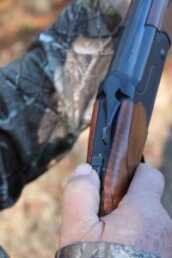
Simply move the safety when on safe right or left to select whether you want the over “O” or top barrel to fire first when you pull the trigger or the under “U” or bottom barrel.
SPECS
- Chambering: .410 (also available in 12, 20 and 28 gauges)
- Barrel: 26 inches
- OA Length: 42 7/8 inches
- Weight: 5 1/2 pounds
- Stock: walnut
- Sights: gold bead front
- Action: break-action, over/under
- Finish: matte wood
- Capacity: 2
- MSRP: $692
Beauty and Value
Practically every over/under built today that doesn’t cost the shooter an arm and a leg is built in Turkey. These are no exception. The prime difference, however, is the difference in quality some Turkish guns have with some being very decent shooters and some being extremely dreadful. I’ve shot some in the past that had just a dreadful variance in point-of-aim/point-of-impact or fired a shot pattern that could leave a balloon intact. The Stevens 555, however, shoots very nicely, or at least my test gun—a .410 bore—did and most of the writers I know who have shot various 555s experienced the same pleasing results on clay and paper regardless of the gauge they were shooting.
Like my test gun, the guns in the entire 555 line are made with a lightweight alloy receiver in a matte black finish that matches the carbon steel stacked barrels. The stock and forearm are made of Turkish walnut and finished in a matte finish that while not fancy, is beautiful in its simplicity. Walnut, in its various forms, has been the wood of choice by gunmakers for ages. It is rigid, durable and attractive and the fine, even grain pattern beneath the matte finish of the 555 I had in hand for testing verified that point. With fine checkering pressed into the forend and pistol grip of the wood, it not only aided grip when swinging and shooting, but added a level of decoration to the otherwise simple finish. The Schnabel forend also featured ergonomic contouring that added to both its visual and practical handling appeal. Indeed, upon pulling the gun straight from its box and assembling it at my farm with other hunters in the room, they all wanted to check it out and noted how nice looking the gun was.
[one_half]
[/one_half]
[one_half_last]

The narrow pistol grip fits nicely in the hand, while the checkering allows for a sure hold even when the shooting action heats up.
[/one_half_last]
The Stevens 555 utilizes internal firing pins operated by a single selective mechanical trigger system. Using the rear tang safety slid to the rear and on safe, the shooter can slide the safety to the right to allow the “U” or under barrel to fire first upon the single trigger pull or to the left to allow the “O” or over barrel to fire first. In either scenario, the shooter simply slides the safety forward when ready to fire, squeezes the trigger to engage the first shot and if a second shot is required, simply pulls the trigger as if firing a semi-auto. Whichever barrel was selected to fire first, the other barrel will simply fire upon initiating the second shot.
[one_third]
[/one_third]
[one_half_last]
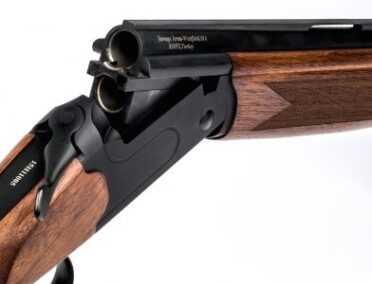
The 555 features extractors (but not automatic ejectors) that help you remove shells from the chambers. Image courtesy of Savage Arms.
[/one_half_last]
The 555 breaks open with a push of the thumb against the rear lever and a little downward force on the forend. In initial testing, it was stiff, but not too stiff. In fact, it was exactly as I would expect a new gun to be and will undoubtedly break open a little easier with proper use. The shotgun features extractors, which lift the shells from the rear of each barrel and allow them to be easily slid the rest of the way out of the gun by hand. There are no automatic ejectors, a downside for a sub-gauge competitor looking to rapidly reload on a four-target station, but a pleasant feature for a shooter not looking to keep chasing down empty shells when they pop over their shoulder.

With many over/under shotguns running shooters in the thousands, the Stevens 555 is as budget friendly as it is attractive.
Shooting the 555 in .410
As noted my test gun was a .410, not a true gauge, but actually a caliber—the odd exception in the shotgun measurement game. The .410 is probably one of the most maligned and misunderstood of today’s modern shotgun sizes. Because of its minimal recoil, light weight and typically shorter overall dimensions, it is often considered a good choice as a first gun for a new or young shooter. Others in the know, however, would vehemently argue nothing could be further from the truth. I personally fall somewhere in the middle as I can see both sides of consideration.
For the very qualities I mentioned, the .410 is a great choice for someone first learning to shoot and getting comfortable with a shotgun, particularly if they are merely shooting at paper or stationary targets set at modest ranges. There are strong benefits that come from building confidence and comfort with a firearm that can aid an individual in continuing down the path as a shooter and hunter and building on those initial marksmanship skills. For someone learning to shoot with a .410, they are going to need to become a good shot for the very reasons many people argue against it as a first gun—the ballistics suck.
The narrow diameter of the shell only allows for a minimal payload that must be stacked deep by making the shell longer, and it must be pushed down the barrel by what is a comparatively smaller charge than bigger shotshells. The result is a load incapable of delivering solid patterns much past 20 yards, 25 tops. In fact, in my experience, most .410s pattern rather poorly. And that is where the Stevens 555 in .410 pleasantly surprised me.
Having been one of those young hunters whose first squirrel guns was in fact, a Stevens break-action single shot in .410, I honestly have a personal fondness for the gauge…er, um, bore. In fact, perhaps more out of sentimental reasons than any real challenge, though it certainly provides that since I have to get much closer, but I take that same little .410 out after winter squirrels. I rarely return without a few, but having toted that raggedy patterning thing out enough over the years, I know to keep shots close if I plan on picking the squirrel in my hand. At 20 to 25 yards I feel my shot is going to hit reliably. Beyond that, not so much. A 30-yard shot is a crap shoot, and as hunters, we should keep our shots in the realm of the reliable.
[one_half]
[/one_half]
[one_half_last]

The twin barrels of the .410 Stevens 555 accept shotshells up to 3 inches long. The author used 2½-inch shells for pattern testing.
[/one_half_last]
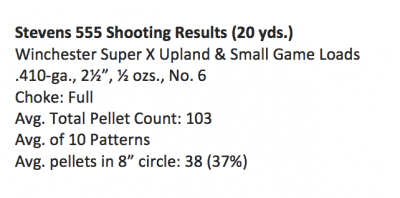 The shotgun employs Beretta/Benelli MobilChoke pattern chokes. With the full choke tube twisted into my top barrel, I tested a box of Winchester Super X Upland & Small Game Loads in No. 6. The results were impressive. At 20 yards, I averaged 38 pellets—all evenly spaced, no ragged holes—or 37 percent of each shell’s payload inside an 8-inch circle. At 25, it fell off roughly 10 percent, but certainly would still bust a clay, knock a squirrel off the limb or drop a gamebird.
The shotgun employs Beretta/Benelli MobilChoke pattern chokes. With the full choke tube twisted into my top barrel, I tested a box of Winchester Super X Upland & Small Game Loads in No. 6. The results were impressive. At 20 yards, I averaged 38 pellets—all evenly spaced, no ragged holes—or 37 percent of each shell’s payload inside an 8-inch circle. At 25, it fell off roughly 10 percent, but certainly would still bust a clay, knock a squirrel off the limb or drop a gamebird.
Deer season ends soon where I hunt so I definitely plan on trying the 555 on a few squirrels and rabbits. We typically invite a group of rabbit hunters to our farm for a couple of weekends of running their beagles in February, and I think the same swinging and handling qualities of the diminutive shotgun that make it a great subgauge gun on the clays course, will apply when trying to put a pattern on a dashing rabbit while standing in a tangle of briars and young pines in a 5-year-old replanted clearcut. Like most light alloy receiver guns, the Stevens is a little front heavy, but to me, that actually enhances its ability to swing neatly on and through our target.

The author used Winchester Super X Upland & Small Game loads in No. 6 to test the shotgun’s pattern at 20 yards.
I really like this gun and think it is a fun little shooter. For more serious clays or bird hunters, I would probably recommend the 28 gauge for those who want to keep weight and recoil to a minimum and max out the shooting challenge and a 20 gauge for the average hunter/shooter looking to balance the best mix of compact size and optimal modern shotshell ballistics. And at $692, it will be as friendly to your wallet as it is to your shoulder every time you fire.
To learn more, visit https://www.savagearms.com/firearms/model/Stevens555.
To purchase on GunsAmerica.com, click this link: https://www.gunsamerica.com/Search.aspx?T=Stevens%20555.

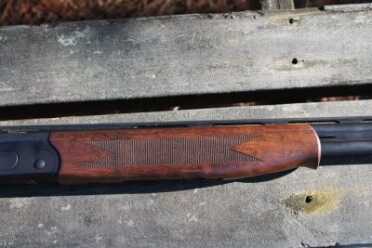
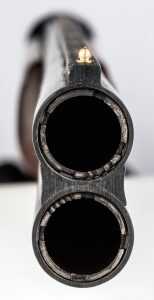

I would just like to correct some of the notions put forth about the .410 in this article.
First off, the ballistics of the .410 do NOT suck. They pattern just like any other gauge shotgun. Part of your misconception stems from your method of patterning your Stevens 555.
You mentioned an 8″ circle as your target…. Wrong. You need to pattern into the center of a 30″ circle at 16 yards. THEN determine the percentage of pellets in and out of that circle. – Looking up the choke numbers for that distance will give you the percentage you SHOULD be getting per choke step; i.e.. F-IM-M-IC-SK-CYL, etc.
I regularly shoot my Browning 725 in .410 at Skeet AND Trap! Even taking it out to the 24 yard line in Trap(that’s 24 yards BEFORE the trap house!) and still score in the 20’s with the occasional 25 straight. And that is with a Modified to Improved Modified Choke. – Again; The .410 does NOT pattern poorly. It patters great! Not susceptible to the “clumping” of shot streams that can happen with 12ga. ammo. – You also said the .410 is “longer” than standard shells… Again. Wrong. The standard shell in all gauges is 2-3/4″. But the .410 is 2-1/2″!! Most .410 shotguns are chambered for 3″ for hunting. But 2-1/2″ is the STANDARD for any clay shooting sports.
You are also basically wrong about .410 being a “beginners” shotgun. For paper targets? Really? If the student is just too young to absorb any kick, then I would say O.K. But to hit any flying targets you really need to start a kid off with 28ga to 20ga. But if your goal in teaching with the .410 is just to get a feel for the game, trigger pull, aiming, etc. then O.K. No problem there.
People have some wired misconceptions about the .410. You included. But in all honesty, they shoot and pattern just like ALL other shotguns, using the same choke tube ratios, etc. The velocities between gauges are all within the same range. About 1100fps to 1300fps aprox. The pattern/shot percentages are the same… the distance of the shot traveled is the same. The only difference is in the NUMBER of shot packed into the shells, -….and the price, of course. – Otherwise I enjoyed your article very much. Thank you.
I have been shooting my 555 20 gauge for 3 seasons . Hunting dove and pheasant. Have shot boxes of shells thru it. Light and heavy loads and dozens at a time at doves with good results and no problems. 1oz loads of 71/2 shot are great to shoot with slight recoil.The gun is sweet to shoot, carries easy and is good looking.
I’m planning on buying a 555 in 28 gauge this week for the fun of it. Gun sale price of $550.
I know these shotguns are for hunting or limited use what with broken firing pins and springs. but saying you can pick up a good used Browning or Beretta for a little more is plain bullcrap. Have you ever looked at the price of a used Browning 410? Better count on spending $1500 or better, same for a Beretta Have seen some of these used for as much as $2000, that’s ridiculous. Seems you can find a 12 or 20 gauge a lot cheaper.
I am an OLD trap and skeet shooter that has always shot Brownings…and an old Remington 1100 Skeet B (truly loved that gun!). My current trap gun is a twice tightened BT-99 purchased in 1976. I have tried a GT, 725, and a BT-100 but always came back to the 99. For skeet I just used my field gun, a Weatherby Orion/SKB. On a lark, I mounted a 555 20 gauge at Cabela’s last year and it fit me so good that I bought it and have shot it ever since for both hunting and skeet. So far I have put well over 10 cases through it and it is still tight as new. (note: I regularly use Krieghoff Gun Glide on pinions and bearing surfaces and a CLP or Tetra on sliding parts). I have a 500 round skeet league starting in a couple weeks (following the end of winter trap league) and plan to shoot the 555 throughout…but will take my old Orion with me just in case. I think the newer Turkish guns are better than the ones of a few years ago. I have two others, a .410 and 12 gauge, and have had no trouble with either, but these do not get shot nearly as much as the 555. The .410 is my preserve pheasant and chukar gun and the 12 mostly sit in one of the gun safes. Anyway, I will “advertise” my experience with the 555 if and when it breaks.
Can tell you from watching people who shoot these kind of shotguns, their OK for hunting for limited use, but will not last weekly 100 round skeet shooting. Seen several Turkish shotguns and other bargain shotguns break firing pins or simply won’t shoot after only a couple Months of use. Save your money and get a Browning , Beretta or a Winchester. Even a well used one will out last one of these “Bargain shotguns.”
If you are buying it just to hunt, or take to the skeet/trap/clays range once or twice a year, then go for it. If you are buying a 555 for use on a weekly or even monthly basis at the range, look elsewhere. You can find a nice used quality O/U for just a little more, and have a gun that will last your lifetime and probably your grandkid’s lifetime.
I’ve been coaching youth shotgun teams for over 20 years. Two years ago we received four (12 and 20ga) of these in a grant from an organization, and we expected to use them as loaners to kids that didn’t have/couldn’t afford shotguns. Three other coaches and I shot them at a few targets when we first received them, and all agreed that the recoil was way too high for what they were – even in the 20ga. We went ahead and let the kids use them, even though we were skeptical.
Three broken firing pins, one broken spring, one that we waited over 3 months for parts, and many bruised shoulders let us know that these were no better than any of the other cheaply made Turkish shotguns. The price is WAY too high for what you get, and the quality is sub-par. If you don’t believe me, go look at a good quality used (and even abused) Browning/Beretta/Etc. and then compare it to the new Stevens.
Yes, I’m a gun snob, but that is only because of the high volume of shooting that my team and I do. We see it all the time – someone brings in a “cheap” Turkish shotgun and it’s only a matter of months before they are trading it in – at a huge loss – on a nice used Browning/Beretta/Etc. Broken springs/firing pins are hard to get, and you really see how bad the quality is on these when you open them up. They look like a high school shop class did the metal work. Don’t even get me started on the included choke tubes! For $700 I would expect a LOT more. The Stevens is so overpriced that all of the shooters that looked at it at our club simply laughed at the price.
Sadly, parents/grandparents/kids buy these because they know the Stevens name, and they love the price. In the end, they regret the decision and buy another gun. I’ve seen it more than enough to know, and it’s really hard on a coach when a kid brings a gun like this in to practice. You know they bought it because they thought it was the best that they could afford, then you feel sorry for them when it breaks or just simply kicks the crap out of them and they can’t afford something else because they spent their money on a Stevens and have NO trade in value.
Again, if this shotgun was in the $300/$400 range, I’d probably buy one to hunt with/knock around. Otherwise, save your money and buy a good quality or used shotgun. You will be money ahead in the long term. And, if you just want a good O/U to go hunt with or occasionally to the range, then look for something else as well – there are many that are as good in quality as the Stevens at a lower price point.
BTW, the four we received were raffled off (as used) and we took the money to buy a couple of good used Brownings…..
Interesting to find a decent over-under at that price. Will try and find one to swing to see how it feels, wold like o try one on upland bird hunting.
I have .410 “Mossberg International Silver Reserve,” which appeared on the-then uncrowded sub-bore market “X” number of years ago before disappearing for some reason I’ve never really been able to understand.. Also, made in Turkey, this little fellow is on the slightly hefty side but it has become one of my most popular shotguns… It consistently amazes me as to its ability – so long as like this story’s author notes – you keep the shots at no more than 25 yards. (I’ve cheated and made a couple of 30 yarders but I don’t recommend such a venture.. I plan to use it over the next few days on some squirrels in a Northeast Ohio woodlot. If I did not all ready have a .410 – or a 28, which I also own – I’d most certainly be eyeing one of these Stevens 555s. Anyone who shoots shotguns more than once or twice a year deserves to tuck away a little of Junior’s college fund and buy a .410 O/U… Now if Steven’s would only produce a 16 gauge 555 I’d be at the local gun shop in a heartbeat. Now there’s an under-rated but serious piece of arsenal.
I too love (and own) the Sweet 16. A few negative comments re: the 555, but none from users/owners. I would hold judgement until I owned, tried or even saw one. Just because something is marketed to a “value” customer does not automatically make it of poor quality. If they are correct about their market, it will sell and maybe make someone quite happy.
Nice looking shotgun! Will definitely check one out. Decent price point. Something Average Joe can afford. Wonder why its more expensive than the semi-auto Stevens that was previously reviewed??? One small detail I like to know with O?U’s is whether or not the safety resets after you open the action. Some do, some don’t. I understand this from a liability standpoint, but personally, I hate it and would have it altered to NOT reset. Very annoying when shooting clays. But that’s a personal thing.
AMERICANISM!!!! NOT Globalism!!!
I agree with the notion of
Americanism! Not Globalism
That being said I find zero interest in a shotgun built out of the US.
Well, I admit to a few old girls that came out of Belgium…
Resetting safety or automatic safety is something usually found on “Field” guns for hunting. To ensure after-shot reloading, the safety goes on.
In almost all cases, this auto-safety feature can be easily changed to a manual safety by any gunsmith or yourself if you learn how.
Auto-Safeties an not desirably on skeet or trap guns because you’d need to switch it back on after every shot.